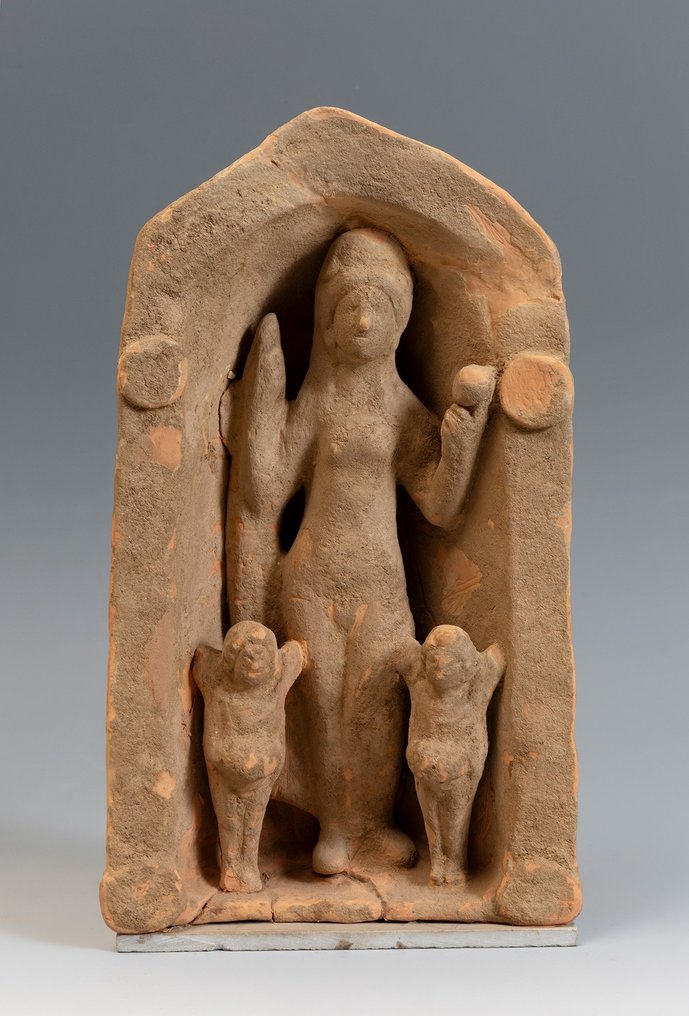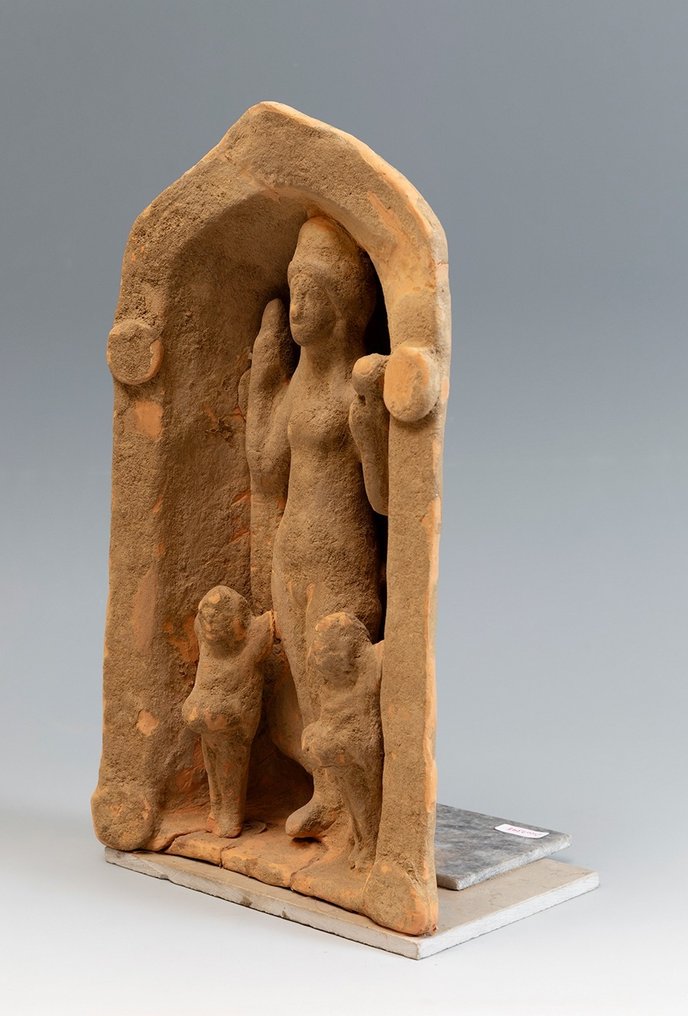Ancient Greek Terracotta Nice stele of goddess of love Aphrodite - Venus with two Eros - Cupid. 27 cm H. Spanish Export
No. 85155463



Nice and pretty stela of goddess of love Aphrodite - Venus with two Eros - Cupid
Venus Chastising Cupid
Ancient Greek, 4th - 2nd century BC
27 heigth and 15 cm large.
PROVENANCE: Private collection Mr. L., south of France, before 1980. Old label in the back.
CONDITION: Good, onlye a breakline in the up of the temple see photos.
DESCRIPTION:
In this intimate sculptural portrayal of a relationship between two divinities, Aphrodite playfully threatens her mischievous son, Eros. The goddess of love wears a stephane--a crown--over her cascading hair and holds a folded cestus--a girdle--just above her shoulder, ready to slap her son. Eros--his wings fully extended--playfully holds up his hand to protect himself.
This scene represents a divine counterpart to the everyday closeness between a mortal mother and her son. During the Hellenistic era, gods and goddesses were often portrayed in a more personal way. This method of representation was a dramatic departure from the earlier Classical style, when the gods were represented more formally as gods, rather than as lighthearted--and humanlike--creatures.
Aphrodite was the goddess of beauty, love and fertility, embodying the primal forces of creation. From the 3rd century BC, she was identified with Venus by the Romans, their local divinity related to the same forces. The goddess, according to Hesiod, was born from foam – the sperm – in the surrounding sea which came from the cut-off genitals of Uranus. In the origins of the Universe, Uranus (the Heavens) mated with Gea (the Earth), engendering various children. But out of fear that they would take the throne from him, he kept them imprisoned in the body of their mother. Cronus, tired of this situation, managed to gain power, castrating his own father and throwing the genitals into the sea:
“From out of the foam a young woman was born. At first, she floated ashore towards the divine Cythera and from there she went to Cyprus… The august and beautiful goddess emerged from the sea, and around her delicate feet grew grass. (…) At first when she was born, and later when she went to join the body of the gods, Eros accompanied her as did the handsome Himeros. And she possessed these attributes (…): intimacy with young maidens, smiles, deceptions, sweet pleasure, love and tenderness.”
Eros, in Greek religion, god of love. In the Theogony of Hesiod (fl. 700 BCE), Eros was a primeval god, son of Chaos, the original primeval emptiness of the universe, but later tradition made him the son of Aphrodite, goddess of sexual love and beauty, by either Zeus (the king of the gods), Ares (god of war and of battle), or Hermes (divine messenger of the gods). Eros was a god not simply of passion but also of fertility. His brother was Anteros, the god of mutual love, who was sometimes described as his opponent. The chief associates of Eros were Pothos and Himeros (Longing and Desire). Later writers assumed the existence of a number of Erotes (like the several versions of the Roman Amor). In Alexandrian poetry he degenerated into a mischievous child. In Archaic art he was represented as a beautiful winged youth but tended to be made younger and younger until, by the Hellenistic period, he was an infant. His chief cult centre was at Thespiae in Boeotia, where the Erotidia were celebrated. He also shared a sanctuary with Aphrodite on the north wall of the Acropolis at Athens. Cupid, ancient Roman god of love in all its varieties, the counterpart of the Greek god Eros and the equivalent of Amor in Latin poetry. According to myth, Cupid was the son of Mercury, the winged messenger of the gods, and Venus, the goddess of love. He often appeared as a winged infant carrying a bow and a quiver of arrows whose wounds inspired love or passion in his every victim. He was sometimes portrayed wearing armour like that of Mars, the god of war, perhaps to suggest ironic parallels between warfare and romance or to symbolize the invincibility of love.
Notes:
- The piece includes authenticity certificate.
- The piece includes Spanish Export License (Passport for European Union) - If the piece is destined outside the European Union a substitution of the export permit should be requested, can take between 1-2 weeks maximum.
- The seller guarantees that he acquired this piece according to all national and international laws related to the ownership of cultural property. Provenance statement seen by Catawiki.
#ancientcivilisations
Seller's Story
Nice and pretty stela of goddess of love Aphrodite - Venus with two Eros - Cupid
Venus Chastising Cupid
Ancient Greek, 4th - 2nd century BC
27 heigth and 15 cm large.
PROVENANCE: Private collection Mr. L., south of France, before 1980. Old label in the back.
CONDITION: Good, onlye a breakline in the up of the temple see photos.
DESCRIPTION:
In this intimate sculptural portrayal of a relationship between two divinities, Aphrodite playfully threatens her mischievous son, Eros. The goddess of love wears a stephane--a crown--over her cascading hair and holds a folded cestus--a girdle--just above her shoulder, ready to slap her son. Eros--his wings fully extended--playfully holds up his hand to protect himself.
This scene represents a divine counterpart to the everyday closeness between a mortal mother and her son. During the Hellenistic era, gods and goddesses were often portrayed in a more personal way. This method of representation was a dramatic departure from the earlier Classical style, when the gods were represented more formally as gods, rather than as lighthearted--and humanlike--creatures.
Aphrodite was the goddess of beauty, love and fertility, embodying the primal forces of creation. From the 3rd century BC, she was identified with Venus by the Romans, their local divinity related to the same forces. The goddess, according to Hesiod, was born from foam – the sperm – in the surrounding sea which came from the cut-off genitals of Uranus. In the origins of the Universe, Uranus (the Heavens) mated with Gea (the Earth), engendering various children. But out of fear that they would take the throne from him, he kept them imprisoned in the body of their mother. Cronus, tired of this situation, managed to gain power, castrating his own father and throwing the genitals into the sea:
“From out of the foam a young woman was born. At first, she floated ashore towards the divine Cythera and from there she went to Cyprus… The august and beautiful goddess emerged from the sea, and around her delicate feet grew grass. (…) At first when she was born, and later when she went to join the body of the gods, Eros accompanied her as did the handsome Himeros. And she possessed these attributes (…): intimacy with young maidens, smiles, deceptions, sweet pleasure, love and tenderness.”
Eros, in Greek religion, god of love. In the Theogony of Hesiod (fl. 700 BCE), Eros was a primeval god, son of Chaos, the original primeval emptiness of the universe, but later tradition made him the son of Aphrodite, goddess of sexual love and beauty, by either Zeus (the king of the gods), Ares (god of war and of battle), or Hermes (divine messenger of the gods). Eros was a god not simply of passion but also of fertility. His brother was Anteros, the god of mutual love, who was sometimes described as his opponent. The chief associates of Eros were Pothos and Himeros (Longing and Desire). Later writers assumed the existence of a number of Erotes (like the several versions of the Roman Amor). In Alexandrian poetry he degenerated into a mischievous child. In Archaic art he was represented as a beautiful winged youth but tended to be made younger and younger until, by the Hellenistic period, he was an infant. His chief cult centre was at Thespiae in Boeotia, where the Erotidia were celebrated. He also shared a sanctuary with Aphrodite on the north wall of the Acropolis at Athens. Cupid, ancient Roman god of love in all its varieties, the counterpart of the Greek god Eros and the equivalent of Amor in Latin poetry. According to myth, Cupid was the son of Mercury, the winged messenger of the gods, and Venus, the goddess of love. He often appeared as a winged infant carrying a bow and a quiver of arrows whose wounds inspired love or passion in his every victim. He was sometimes portrayed wearing armour like that of Mars, the god of war, perhaps to suggest ironic parallels between warfare and romance or to symbolize the invincibility of love.
Notes:
- The piece includes authenticity certificate.
- The piece includes Spanish Export License (Passport for European Union) - If the piece is destined outside the European Union a substitution of the export permit should be requested, can take between 1-2 weeks maximum.
- The seller guarantees that he acquired this piece according to all national and international laws related to the ownership of cultural property. Provenance statement seen by Catawiki.
#ancientcivilisations
Seller's Story
- 755
- 7
- 0
goede foto's, goede omschrijving, goed verpakt en snel verzonden.
View translationmolto bello tutto ok
View translationPezzo come da descrizione, davvero notevole. Venditore molto consigliato in quanto gentile e disponibile. spedizione molto veloce. Ottimo!
View translationVenditore davvero ottimo e gentile. Merce come da descrizione, spedizione veloce. Ottimo l'avere certificato di autenticità.
View translationUn 100 como empresa un 100 como envío . Empresa muy especial con mucha exquisitez en todos los productos y en personal . Muchas gracias
View translationAll well! Thanks.
View translationVery nice and fine cut little jewel! Well packed too! Thanks!
View translationnice piece and very fast shipping!
View translationEs una maravilla de moneda, donde se le nota los pasos de los años y me encanta. Servido muy rápido y bien empaquetado. Con su certificación. Qué más se puede pedir?
View translationSnelle en correcte levering, alleen was de verpakking voor het schilderij niet stevig genoeg.
View translationHerzlichen Dank!
View translationAll OK and with very fast shipping.
View translationPrachtig schilderij. Zo blij mee. Zeer nette verkoper en zeer snelle levering.
View translationperfect ! very fast and high quality delivery !
View translationAll well! Thanks.
View translationVendeur très professionnel, top +++×
View translationPhotos trop contrastées pour bien percevoir les défauts, mais ces défauts étaient visibles pour autant. Le "Bon état" est trompeur. Sinon, envoi rapide et correctement emballé. Frais de port exagérés.
View translationGreat communication, delivery and product. Came with a well made certificate of authenticity and good packaging. Overall very happy with the purchase! Delivery is a bit expensive, but I recommend it
View translationMagnifique témoin du passé, envoyé avec tous les justificatifs, impeccable. Encore une fois très satisfait, un grand merci
View translationThank you for the Special offer and the fast shipping of this excellent piece of art!
View translationvery good description of the object, very good price for this rare item,. Fast sending (has been at my place 2 days after buying!). Definitely would buy again.
View translationSehr schön
View translationAs described, perfect logistic
View translationgreat seller, everything came as should with certificate of authenticity
View translation- 755
- 7
- 0
Disclaimer
The seller guarantees and can prove that the object was obtained legally. The seller was informed by Catawiki that they had to provide the documentation required by the laws and regulations in their country of residence. The seller guarantees and is entitled to sell/export this object. The seller will provide all provenance information known about the object to the buyer. The seller ensures that any necessary permits are/will be arranged. The seller will inform the buyer immediately about any delays in obtaining such permits.
The seller guarantees and can prove that the object was obtained legally. The seller was informed by Catawiki that they had to provide the documentation required by the laws and regulations in their country of residence. The seller guarantees and is entitled to sell/export this object. The seller will provide all provenance information known about the object to the buyer. The seller ensures that any necessary permits are/will be arranged. The seller will inform the buyer immediately about any delays in obtaining such permits.









